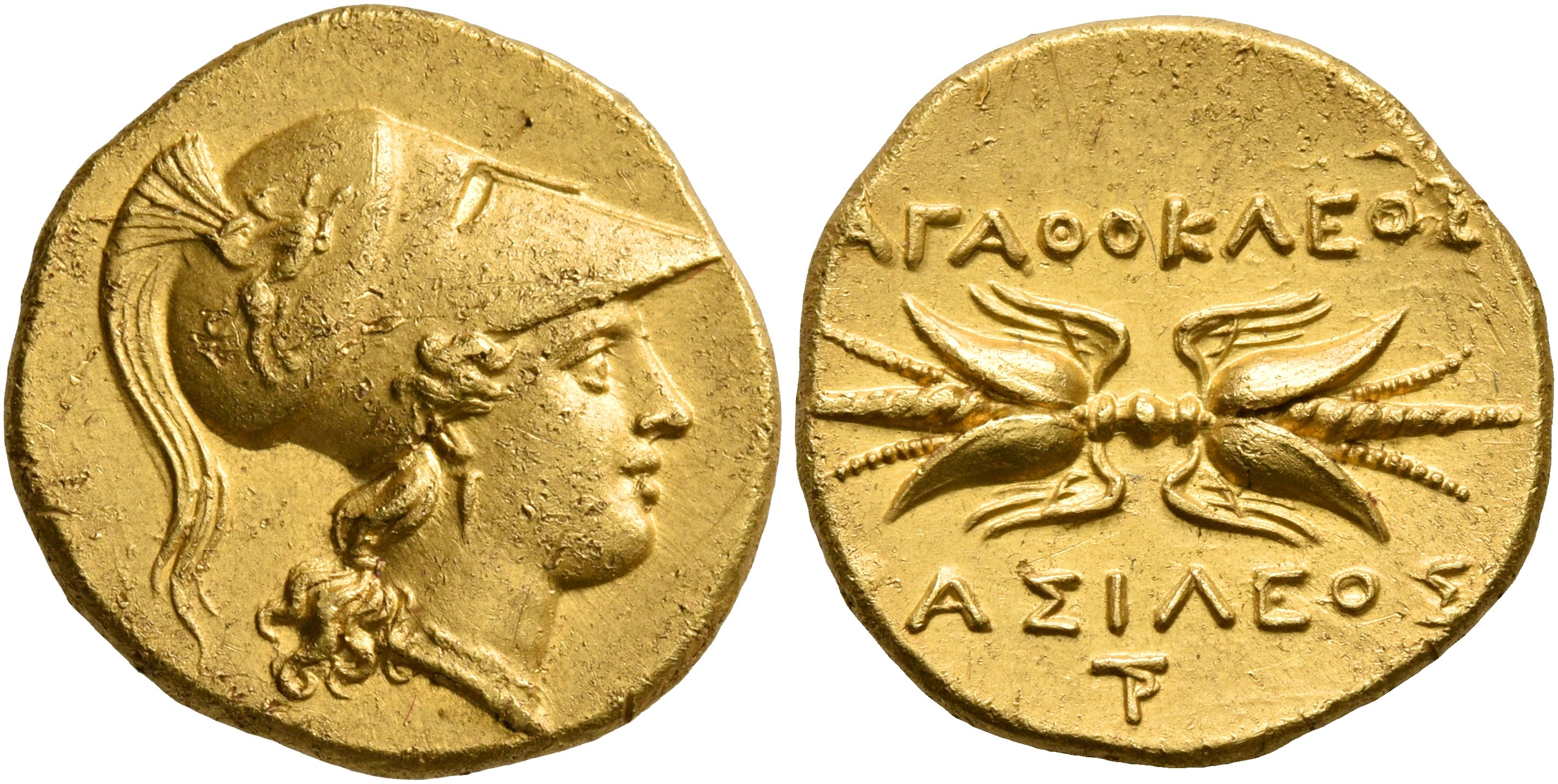Syracuse (Agathocles), gold, staters (Athena/thunderbolt) (317-310 BCE)
From SILVER
317 BCE - 310 BCE Gold 8,633 kg
Description
| ObverseInscription or printing placed on the obverse.: | Head of Athena to right, wearing crested Corinthian helmet decorated with a griffin on the bowl, pendant earring and pearl necklace |
| ReverseInscription or printing placed on the reverse.: | BAΣΙΛΕΩΣ AΓAΘOΚΛEΟΣ (Greek).Winged thunderbolt. In the field, monogram. |
Mint and issuing power
| MintIdentifies the place of manufacture or issue of a numismatic object.: | Syracuse | Ancient regionAncient region.: | Sicily | Modern countryModern country: Italy | AuthorityIdentifies the issuing power. The authority can be "pretended" when the name or the portrait of X is on the coin but he/she was not the issuing power. It can also be "uncertain" when there is no mention of X on the coin but he/she was the issuing power according to the historical sources: | Agathocles of Syracuse (tyrant of Syracuse in 317-289 BC and self-styled king of Sicily in 304-289 BC) |
Chronology
| FromIdentifies the initial date in a range assigned in a numismatic context. | 317 BCE | toIdentifies the final date in a range assigned in a numismatic context.. | 310 BCE | PeriodTime period of the numismatic object.: Hellenistic 323-30 BC |
Physical description
| MetalThe physical material (usually metal) from which an object is made.: | Gold |
Median weightMedian of the weights of numismatic objects (in grams). in grams | 5.65 | DenominationTerm indicating the value of a numismatic object. Examples: tetradrachm, chalkous, denarius.: | stater |
StandardStandard.: |
Image

S 354 - Syracuse, gold, stater.jpg [1]
References
| Die study referencePublication of the study: | Bérend 19981Bérend 1998 | ||
| Coin series referenceReference to coin series study: | Sear I2Sear I, n° 970, HGC 23HGC 2, n° 1535 | ||
| Coin series web referenceCoin series web references: | |||
Obverse dies distribution
| FrequencyFrequency of specimen in distribution. ᵖ | Number of obversesNumber of obverse dies. ᵖ (o) | % (o) | Number of coinsNumber of coins. (n) | % (n) | Die nameName(s) of the die(s). |
| 1 | 1 | 16.67 | 1 | 5.56 | 2 |
| 3 | 3 | 50 | 9 | 50 | 4, 5, 6 |
| 4 | 2 | 33.33 | 8 | 44.44 | 1, 3 |
| Total | 6 of 6 | 100 | 18 of 18 | 100 |
Reverse dies distribution
no distribution is available
Quantification
| Number of obversesNumber of obverse dies. ᵖ (o) | 6 | Number of singletons (o1)The number of singleton coins. ᵖ | 1 |
| Number of reverse diesNumber of reverse dies. (r) | 7 | Number of coinsNumber of coins. (n) | 18 |
| Coins per obverse dieNumber of coins per obverse die. (n/o) | 3 | Coins per reverse dieNumber of coins per reverse die. (n/r) | 2.57 |
| Reverse per obverse ratioRatio of obverse dies divided by reverse dies. (r/o) | 1.17 | Percentage of singletons (o1)number of coins (n) divided by the number of singletons (o1) ᵖ | 16.67 % |
| Original number of dies (O) (Carter 1983 formula)The estimation of the number of coins according to Carter 1983 ᵖ | 7.64 | Coins struck if 20,000 as average productivity per dieCoins made if the average productivity for obverses (according to Carter) is 20,000. ᵖ | 152,800 |
| Original number of dies (O) (Esty 2011 formula)The estimation of the number of coins according to the singleton formula in Esty 2011 ᵖ (O) | 9 | Survival rate if 20,000 as average productivity per dieSurvival rate if average productivity is 20,000. ᵖ | 0.00012 |
| Coverage (o = % of O) (Esty 1984 formula)Esty 1984 - coverage (% of O) ᵖ (o = % of O) | 94.44% | Die productivity if survival rate 1/2,000Average productivity if survival rate is 1/2,000. ᵖ | 4,712.04 |
| Weight of silver (in kg) if 20,000 coins per die (O = Carter formula)Carter 1983 * Median weight * 20000 (*10 if gold or electrum) ᵖ | 8,633 kg <br /> 8,633 kg | Die productivity if survival rate 1/5,000Average productivity if survival rate is 1/5,000. ᵖ | 11,780.1 |
Remarks
Most likely more than 2 workstations Likely military